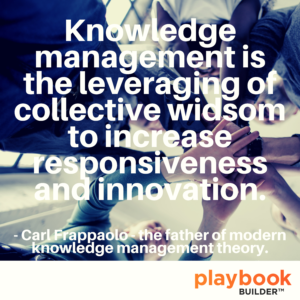The Knowledge Management Advantage
As a civilization, we are experiencing an insidious creep in time constraints, complexity, and pacing. Technology of every type has had the greatest influence in this. The change is subtle enough that we’re not alarmed…but we’re certainly experiencing a low-grade overwhelm.
For business owners and leaders, the questions are different. How to keep up with the pace of change? How to inoculate my tribe against apathy? How to keep my team aligned when the plays keeps changing? And finally, how to ensure our new hires have an onboarding experience that’s so unique and engaging that they will stay?
If you haven’t heard, this is a Knowledge Management issue. It’s not that you don’t know how to do things – you do. You simply aren’t sharing those best practices, principles, and procedures (knowledge) EQUALLY across your growing organization. What frustrates you (or certainly should) is that you already know how everything ought to be done. It’s the gap in tribal knowledge that’s harming your growth goals.
Imagine you’re coaching a team. Think NFL or NBA or your kids softball team. It is the same thing. You’re the coach. You know how it ALL should be done. You studied the game. Created every play. Selected every player. But you’re not supposed to run up and down the field / court with he ball- that’s what the PLAYERS do. You’re there to coach and if your team don’t know how to run the plays perfectly and consistently you need to solve it.
Start with the team playbook and drill, drill, drill on the plays.
Here’s a workable definition from the “father of modern knowledge management theory” – Carl Frappaolo.

So now what? Well, here’s how you can get started tackling this important activity.
First: Look at the business objectively. Where is there the most pain? Onboarding new people? Transitioning veterans out? Missing sales? M&A? It could be anything but you need to prioritize so considering a point of pain shared by the organization is crucial.
Second: Map a process and interview an SME (subject matter expert). They will – if you interview them – share all kinds of wisdom. Stories. How To’s. Checklists they have up in their heads. Even role playing which can be transcribed into a script. It’s rich in there so spend a little time asking WHY not just HOW.
Third: Once you’ve built it don’t expect them to come. Actively work to get everyone into your platform. If you use a knowledge management tool like PlaybookBuilder or something else – you have the same goal – to DRIVE engagement. This is change management stuff and while not hard – requires diligence, leverage from leadership, and creativity. You’ll deal with the complaining, “why do we need a new login?” and “we tried this before” but remain steadfast! Once you drive familiarity and this has moved beyond the “bright and shiny object” phase and you’re STILL pushing it, they’ll catch on. It takes time.
Knowledge management means you’re leveraging collective wisdom. You have it. Your team has it…but it’s locked up in their heads. Now go out and get it and turn it into the fuel to meet your goals.
Jon LoDuca
founder
PlaybookBuilder
